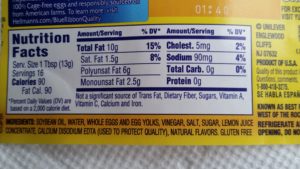 Artificial trans fats in foods are bad for health in so many ways: linked to increased risk of coronary heart disease, atherosclerosis, inflammation, and risk of early death. And even though the FDA is finally phasing out partially hydrogenated oils (because they have high levels of artificial trans fats) within the next 3 years, trans fats will still be found in foods (processed foods). How can this be? Well, trans fats are still allowed to be in foods that are labeled as 0 trans fats if it is less than .5 grams trans fats per serving (a loophole allows them to round downward to zero ). And according to research by Environmental Working Group (EWG), trans fats are being used by the food industry in undisclosed ways in amounts low enough to exploit the trans fat loophole. Besides partially hydrogenated oils, they are found in other types of refined oils, monoglycerides, diglycerides and other emulsifiers, and even in flavors and colors. So when you see ZERO trans fats on the label, it doesn't actually mean that it is zero trans fats. The problem is that over the course of a day, eating a number of foods and servings that have under .5 grams of trans fats adds up to levels that research now says has negative health effects!
Artificial trans fats in foods are bad for health in so many ways: linked to increased risk of coronary heart disease, atherosclerosis, inflammation, and risk of early death. And even though the FDA is finally phasing out partially hydrogenated oils (because they have high levels of artificial trans fats) within the next 3 years, trans fats will still be found in foods (processed foods). How can this be? Well, trans fats are still allowed to be in foods that are labeled as 0 trans fats if it is less than .5 grams trans fats per serving (a loophole allows them to round downward to zero ). And according to research by Environmental Working Group (EWG), trans fats are being used by the food industry in undisclosed ways in amounts low enough to exploit the trans fat loophole. Besides partially hydrogenated oils, they are found in other types of refined oils, monoglycerides, diglycerides and other emulsifiers, and even in flavors and colors. So when you see ZERO trans fats on the label, it doesn't actually mean that it is zero trans fats. The problem is that over the course of a day, eating a number of foods and servings that have under .5 grams of trans fats adds up to levels that research now says has negative health effects!
Artificial trans fats are found in a lot of processed foods. A EWG analysis found that harmful artificial trans fatty acids lurk in more than 27 percent of more than 84,000 processed foods common in American supermarkets. Another 10 percent contain ingredients likely to contain trans fat. Foods most likely to have hidden trans fats are: breakfast bars, granola and trail mix bars, pretzels, peanut butter, crackers, breads, kids fruit snacks, kids cereal, graham crackers, whipped topping, non-dairy creamers, pudding mixes, cupcakes, and ice cream cones.
So what can you do? Read ingredient lists on labels and try to avoid foods with the above mentioned ingredients: partially hydrogenated oils, emulsifiers, monoglycerides, diglycerides and other emulsifiers, artificial flavors, artificial flavors, and colors. Try to cut back or avoid foods that have ingredients that are not real foods - tough to do, but it can be done.
And the amazing part, saturated fats (such as butter) are NOT linked to early death and heart disease, but trans fat in foods is. Latest research, from Science Daily:
A study led by researchers at McMaster University has found that that trans fats are associated with greater risk of death and coronary heart disease, but saturated fats are not associated with an increased risk of death, heart disease, stroke, or Type 2 diabetes. The findings were published today by the British Medical Journal (BMJ)...."For years everyone has been advised to cut out fats. Trans fats have no health benefits and pose a significant risk for heart disease, but the case for saturated fat is less clear," said de Souza.
Saturated fats come mainly from animal products, such as butter, cows' milk, meat, salmon and egg yolks, and some plant products such as chocolate and palm oils. Trans unsaturated fats (trans fats) are mainly produced industrially from plant oils (a process known as hydrogenation) for use in margarine, snack foods and packaged baked goods.
Contrary to prevailing dietary advice, a recent evidence review found no excess cardiovascular risk associated with intake of saturated fat. In contrast, research suggests that industrial trans fats may increase the risk of coronary heart disease.
To help clarify these controversies, de Souza and colleagues analysed the results of 50 observational studies assessing the association between saturated and/or trans fats and health outcomes in adults....The team found no clear association between higher intake of saturated fats and death for any reason, coronary heart disease (CHD), cardiovascular disease (CVD), ischemic stroke or type 2 diabetes. However, consumption of industrial trans fats was associated with a 34 per cent increase in death for any reason, a 28 per cent increased risk of CHD mortality, and a 21 per cent increase in the risk of CHD.
Inconsistencies in the studies analysed meant that the researchers could not confirm an association between trans fats and type 2 diabetes. And, they found no clear association between trans fats and ischemic stroke. The researchers stress that their results are based on observational studies, so no definitive conclusions can be drawn about cause and effect.

